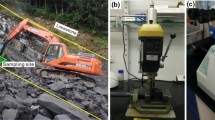Abstract
Our understanding of progressive cracking in rock materials is very important for prediction of failure in rock engineering. Gathering three-dimensional observation of damage evolution process in rock materials has been a challenge. In this article, we realized imaging of cracking in oil shale during uniaxial compressive test using X-ray micro-computed tomography (CT) technology with a resolution of 11.27 μm. We also had fully resolved sequences of micro-cracks damage and cracks growth at different positions and stress levels. The results indicated that the micro cracks initiated at the boundary of specimens, and suffered continuous development during the process including branching, coalescence, and failure. The unstable propagation stage of cracks was assumed to be very close to the peak strength. Continuous loading enlarged the width of the cracks in the failed specimen. However, few new cracks were generated. Besides, several parameters such as the crack length (CL) and fracture network volume (FNV) were selected to quantitatively describe the cracking and damage evolution process. The cracking process, especially the propagation and formation of fracture network, can be precisely characterized these parameters. Our observations provide a powerful methodology for characterizing the dynamic changes in oil shale by fracturing treatment for the improvement and optimization of hydrocarbon recovery.







Similar content being viewed by others
References
Bale HA, Haboub A, Macdowell AA et al (2013) Real-time quantitative imaging of failure events in materials under load at temperatures above 1,600 °C. Nat Mater 12(1):40–46
Chen X, Xu Z (2016) The ultrasonic P-wave velocity-stress relationship of rocks and its application. B Eng Geol Environ 76(2):1–9
Dyskin AV, Sahouryeh E, Jewell RJ, Joer H, Usyinov KB (2003) Influence of shape and locations of initial 3-D cracks on their growth in uniaxial compression. Eng Fract Mech 70(15):2115–2136
Ju Y, Wang L, Xie H, Ma G, Mao L, Zheng Z, Lu J (2017) Visualization of the three-dimensional structure and stress field of aggregated concrete materials through 3D printing and frozen-stress techniques. Constr Build Mater 143:121–137
Li X, Duan Y, Li S, Zhou R (2017) Study on the progressive failure characteristics of Longmaxi shale under uniaxial compression conditions by X-ray micro-computed tomography. Energies 10:303
Liu Y, Hou J, Zhao H, Liu X, Xia Z (2018) A method to recover natural gas hydrates with geothermal energy conveyed by CO2. Energy 144:265–278
Luo Z, Zhang N, Zhao L, Yao L, Liu F (2018) Seepage-stress coupling mechanism for intersections between hydraulic fractures and natural fractures. J Pet Sci Eng 171:37–47
Luo Z, Zhang N, Zhao L, Ran L, Zhang Y (2019) Numerical evaluation of shear and tensile stimulation volumes based on natural fracture failure mechanism in tight and shale reservoirs. Environ Earth Sci 78:1–15
Martínez-Martínez J, Fusi N, Galiana-Merino JJ, Bebavente D, Crosta GB (2016) Ultrasonic and X-ray computed tomography characterization of progressive fracture damage in low-porous carbonate rocks. Eng Geol 200:47–57
Nie B, He X, Li X, Chen W, Hu S (2014) Meso-structures evolution rules of coal fracture with the computerized tomography scanning method. Eng Fail Anal 41(5):81–88
Raynaud S, Vasseur G, Soliva R (2012) In vivo CT X-ray observations of porosity evolution during triaxial deformation of a calcarenite. Int J Rock Mech Min 56(15):161–170
Sahouryeh E, Dyskin AV, Germanovich LN (2002) Crack growth under biaxial compression. Eng Fract Mech 69(18):2187–2198
Saif T, Lin Q, Gao Y, Al-Khulaifi Y, Marone F, Hollis D et al (2019) 4D in situ synchrotron X-ray tomographic microscopy and laser-based heating study of oil shale pyrolysis. Appl Energy 235:1468–1475
Sufian A, Russell AR (2013) Microstructural pore changes and energy dissipation in Gosford sandstone during pre-failure loading using X-ray CT. Int J Rock Mech Min 57(1):119–131
Viggiani G, Lenoir N, Bésuelle P, Michiel MD, Marello S, Desrues J, Kretzschmer M (2004) X-ray microtomography for studying localized deformation in fine-grained geomaterials under triaxial compression. CR Mecanique 332(10):819–826
Wang Y, Li C, Hao J, Zhou R (2018) X-ray micro-tomography for investigation of meso-structural changes and crack evolution in Longmaxi formation shale during compressive deformation. J Pet Sci Eng 164:278–288
Wu K, Zhang X, Jing L, Li F, Jin Z, Xiao H (2017a) Wettability effect on nanoconfined water flow. P Natl Acad Sci USA 114(13):3358–3363
Wu K, Zhang X, Li F, Jin Z, Jing L, Wang K, Wang H, Wang S, Dong X (2017b) Flow behavior of gas confined in nanoporous shale at high pressure: Real gas effect. Fuel 205:173–183
Yang SQ, Yang DS, Jing HW, Li YH, Wang SY (2012) An experimental study of the fracture coalescence behaviour of brittle sandstone specimens containing three fissures. Rock Mech Rock Eng 45(4):563–582
Yin S, Zhao D, Zhai G (2016) Investigation into the characteristics of rock damage caused by ultrasonic vibration. Int J Rock Mech Min 84:159–164
Zabler S, Rack A, Manke I, Thermann K, Tiedemann J, Harthill N, Riesemeier H (2008) High-resolution tomography of cracks, voids and micro-structure in greywacke and limestone. J Struct Geol 30(7):876–887
Acknowledgements
The authors also would like to particularly thank Dr. Jin Hao (Institute of Geology and Geophysics, Chinese Academy of Sciences) for their consistent support, patience and guidance throughout the experiment procedure.
Funding
The research is supported by the National Natural Science Foundation of China (Grant Nos. 41902303), Sichuan Youth science & Technology Foundation (2017JQ0010), National High Technology Research & Development (2016ZX05053), Key Fund Project of Educational Commission of Sichuan Province (16CZ0008), and Explorative Project Fund (G201601) of State Key laboratory of Oil and Gas Reservoir Geology and Exploitation (Southwest Petroleum University).
Author information
Authors and Affiliations
Corresponding author
Ethics declarations
Conflict of interest
The authors declare no competing interests.
Additional information
Responsible Editor: Santanu Banerjee
Rights and permissions
About this article
Cite this article
Lin, C., He, J., Liu, Y. et al. Quantitative characterization of cracking process in oil shale using micro-CT imaging. Arab J Geosci 15, 301 (2022). https://doi.org/10.1007/s12517-021-09405-0
Received:
Accepted:
Published:
DOI: https://doi.org/10.1007/s12517-021-09405-0




